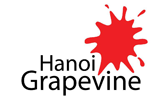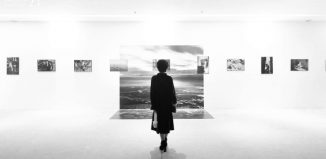Vo Tran Chau: Every used piece of cloth has a story

1 of the 4 pixelate images of the textile factories
Written by Ha Bi for Hanoi Grapevine
Translated by Hong Dinh Vu
Photos provided by the author
Kindly credit Hanoi Grapevine when sharing the article
Please do not copy or repost without permission
Thousands of shirts lying in unclaimed containers on the harbor were collected and turned into artworks by Vo Tran Chau in “Leaf Picking in the Ancient Forest”. The old shirts were given a new life, becoming a story that perhaps each of us played a part in.
Vo Tran Chau is one of the few artists in Vietnam who chooses fabric as creative materials and harmoniously combines them with photography. Born and raised in a family with embroidery tradition, she knows better than most the power of each thread and needle, each type of fabric, especially used fabric. They may be trendy fashions for ladies; a warm coat shielding someone from a cold winter night; or easily reusable as a wiping cloth or mat; at the same time, it can be a great material for art.
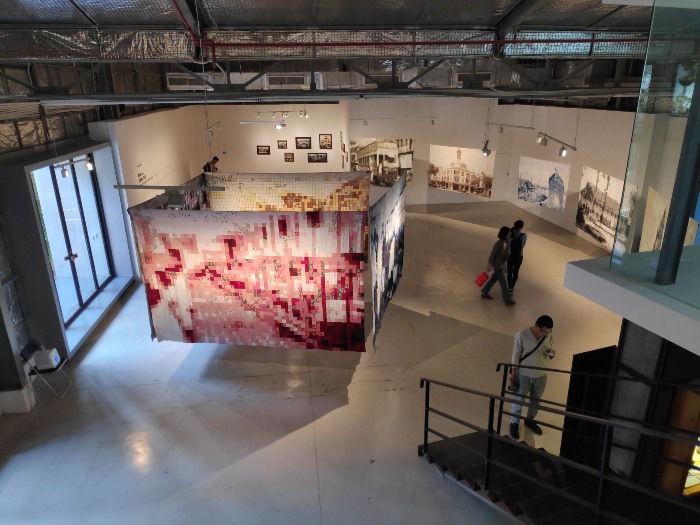

“Leaf Picking in the Ancient Forest” exhibition space
Approximately 20 works made entirely from used cloth have been on display from 14 Feb to 10 April 2020 at The Factory Contemporary Arts Centre. Unfortunately, the exhibition is temporarily closed, due to Covid 19.
To Vo Tran Chau, “Leaf Picking in the Ancient Forest” is her largest solo exhibition. Each of the artworks displayed here is the result of a meticulous feat that she had been working on for two years. She collected used cloth and old clothes from unclaimed ships scattered throughout Saigon’s ports, especially Cat Lai port. She gave the good stuff to people in need. As for the rest, she and several colleagues classified the fabric pieces according to their color tone, and then combined them into “paintings”.
During the implementation process, Tran Chau many times found herself in confusion over the excessive production and consumption of the fashion industry as well as its impact on the environment. “You have to go there, looking at the “mountain” of piled-up clothes with a lot of good usable stuff in it. You will have to wonder, did I play a part in this situation?” – Chau said in a talk with the audience at The Factory a week after the exhibition opening.
To understand more about “Leaf Picking in the Ancient Forest” and its creative process of this interesting exhibition, come join Hanoi Grapevine in a talk with the artist – Tran Chau.
Why did Chau choose to use old cloth and clothes as the primary material for these works?
I majored in lacquer and have 10 years of practicing contemporary art. But I like fabric the most because I grew up in my family’s sewing factory. Another reason is that I want to minimize the amount of waste released into the environment even in the creative process. Perhaps, destiny is also a factor.
The number of used items that I collected for this exhibition really impressed me. You can see the 4 works in the center of the gallery forming a circle, those are images of 4 textile factories. All of them were torn down to build new urban areas. Vietnam is one of the 10 largest clothing exporters in the world. Then the products come back to us, but in the form of trash. Along with the growth of that clothing mountain is the disappearance of cultural heritage. I want to use things no one can use anymore to recreate images of the past, which are all almost gone. In a certain sense, they are connected and indicative to each other.


Pixelated image of Tra Co Church and photo
“Leaf Picking in the Ancient Forest” consists of hanging mosaic “paintings”, did you choose this expression unintentionally or on purpose?
The process of creating this works has a bit to do with history, so I turned to Tran Quang Duc, a person with a great understanding of history for more knowledge. Duc and I share the same opinion.
That is, in fact, when looking back to the past, we cannot see anything clearly. What we feel is just “seeing” through the perspective of others and are not certain if it is the “pure truth.” Meeting people, listening to stories, we collect pieces to form an image of the past. But no matter how objective, there are things we cannot see clearly. Historians therefore may not be entirely accurate. The image or information will fade, just like when you look at a “pixelated” image of a mosaic. At that time, we need to “slow down” to look “deeper”.
There was a discovery when I did this project. When the works were finished, I took pictures with a camera and found out that the works on photo look different from real life. It was an interesting point that I didn’t intend to create.

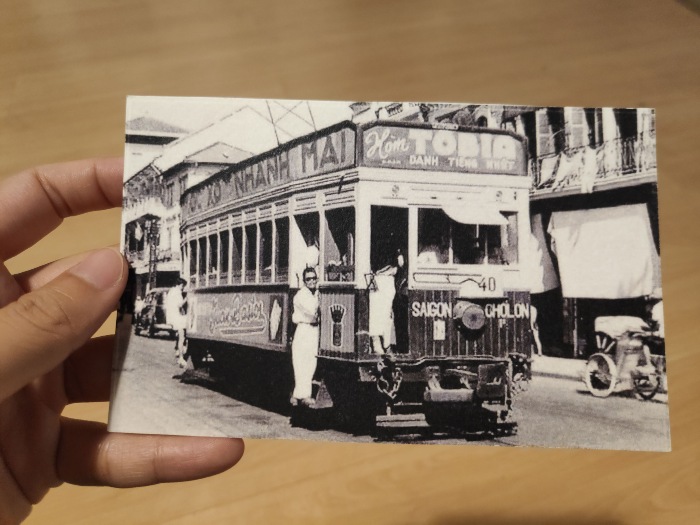
Pixelated image of electric train and photo
How did you create these works? How was the time and feeling you spent for them?
I selected the images first. Most of the buildings were demolished, so it was impossible to take pictures by yourself but to use documentary photos. The images taken from the Internet. Some have sources, which I asked for permission. Some I could not find the authors. These images, I assessed them visually, to see if they were beautiful enough, if they were structurally comprehensive, and clear enough to withstand pixelation.
Then, I processed the image, converted it into pixels, numbered according to the color code on the image. Then I chose the color tone of the fabric, numbered the color code of the fabric and put it together.
I spent my time living with the art works. Depending on the work, it may take months or weeks. Small pieces on wooden frames took less time, the larger ones sometimes took 1 – 1.5 months. I was not in a hurry but enjoyed cutting and putting it together every day. As I worked, I thought about the story behind. It is also a way to practice perseverance. I love that slow pace, even though a tailor lent their help with some of the works.
Were the color tones you chose for the works based on real-life objects or on emotions?
Chau respects the truth, but with art, much of it is about emotions.
Besides, this depends on the actual images and fabric you have. Maybe the original picture is in black and white, but my work would be in blue or red. For example, the color of the textile factory was bright red or blue. I just used whatever I had on hand, because it was all old fabric. It reflected fashion trends as well.
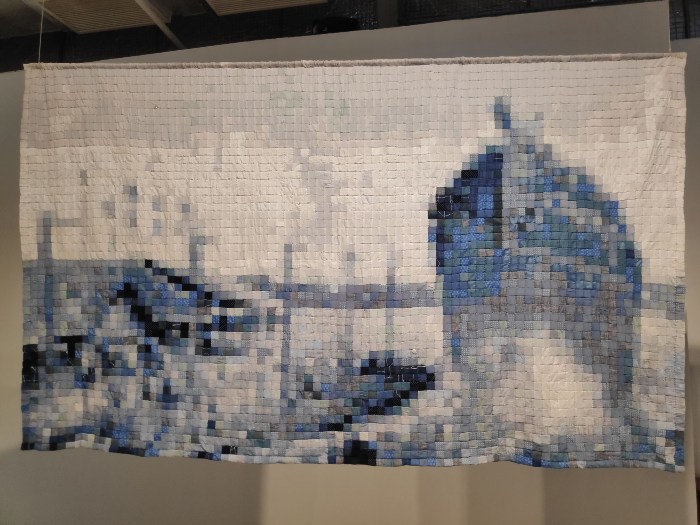

Each work was carefully put together from old fabric
NDoes the name “Leaf Picking in the Ancient Forest” have a hidden meaning?
I chose the name “Leaf Picking in the Ancient Forest” for many reasons, it is quite personal. I used to study at Gia Dinh school for 5 years. Everyday on the way to school I passed by several mansions and I really liked that. But later on they were demolished, making me feel extremely down. Chau did not intentionally choose a particular region, but it was mainly Saigon – where Chau lived for more than 30 years and had many feelings for it.
Then Chau came by a story. That Buddha, with leaves in his hand, once said to the bhikkhus: “What I have known I have told you only a little [like the leaves on this hand], what I have not told you [like the forest] is very much more”. This is the story that inspired me. I decided on the name “Leaf Picking in the Ancient Forest” to express how I chose to join the discussion on heritage conservation. The pieces of history that I brought into the works were like a bunch of leaves in my hand. What I didn’t know and lay outside this exhibition was like a vast forest. I just try to keep for myself a piece of memory about them in this way.

Pixelated images of houses
So do you believe that we should not destroy heritages?
No. I believe life is impermanent. Everything is born, changed, destroyed and reborn. Nothing is forever.
For example, when I went on a field trip to Bui Chu Church, it was not yet demolished. The Internet community at that time was very angry because the church was beautiful. I, like many others, came to visit it the last time with grief. I met several heritage preservation groups and parishioners here. Then I realized that everyone seemed a little aggressive, looking in from the outside and thought they were right, they had to keep the church. Yet the pastor and the parishioners were… happy with the demolition! We weren’t there, didn’t know it was degraded to the point it could collapse at any time. Thus we, from the outside, kept demanding someone to keep their own house.
Chau is still very sorry when a beauty is lost, like the case of Bui Chu. I think it can be restored instead of demolished. If we tear down everything, where is the history to tell? But we also need to respect the present. And Chau kept my position of an observer, a storyteller of history.
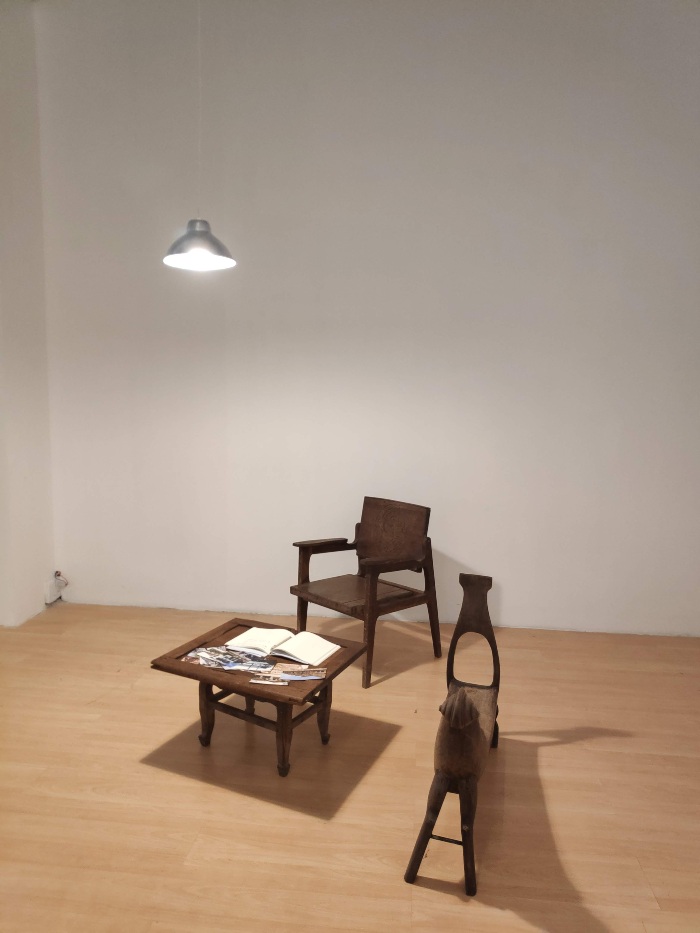

A memory corner for the audience to see the original images
How do you think your works will make an impact on your audience?
I hope that the passion that I put into the work would touch the hearts of the audience. Hope that “Leaf Picking in the Ancient Forest” creates a space of memories where people can calm down amidst the rapid changes happening around each of us.
Thank you for spending time with us.
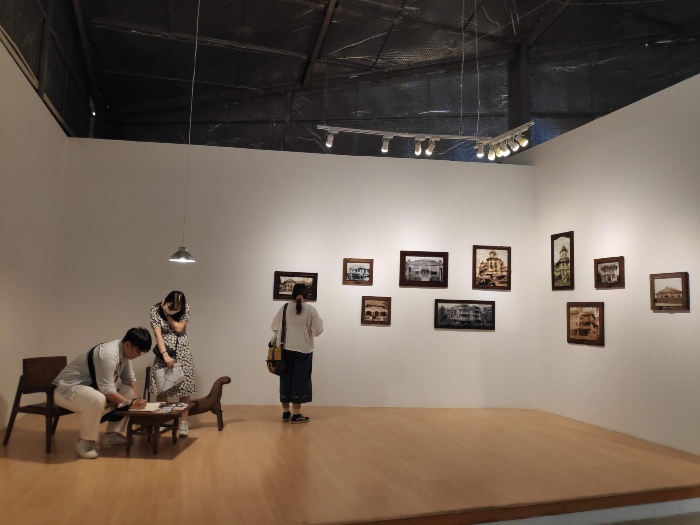

Enjoying the exhibition through the digital screen, you will see the magic of this mosaic art work
By recreating the past and the history with the used and discarded materials, Vo Tran Chau posed questions about how each locality absorbs cultures in the development process, and expressed her concerns about social ethics and history. Come to The Factory to enjoy this exhibition, and be sure to bring a digital camera or phone to see the effects of Vo Tran Chau’s fabric mosaic art works.
